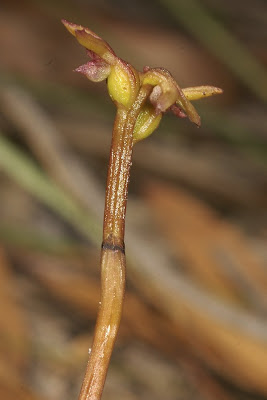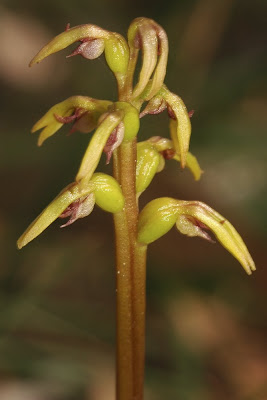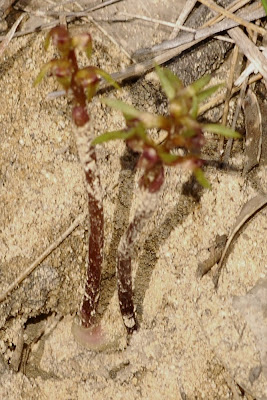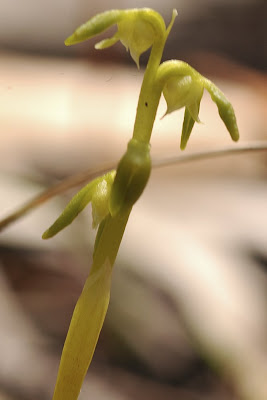Two spikes side by side - one mature, one at bud stage.

These plants are very fortunate, as, thanks to Alan's research, lobbying, and dare I say it, persistence - these plants are in an area which Peter Garrett has deemed to be protected under the Federal EPBC Act. The Minister's intervention was as a result of the Shoalhaven Council's original intention to re-zone this patch of land for residential development. It is that action which Minister Garrett has refused to allow, because of the threat it posed to "Matters of National Environmental Significance" (i.e., threatened species listed under the EPBC Act.) In this case, it is an incidental protection, as this species is not listed there, but these plants have chosen their neighbours well, for the Leafless Tongue Orchid also lives in this same area.
This is a mature flower spike.Note the yellowish-brown stem,
and the yellowish-green tones of the lateral sepals
 This images shows the tip of the leaf,
This images shows the tip of the leaf,through which the flower scape protrudes.
 This is a small stem, with just 3 flowers.
This is a small stem, with just 3 flowers.The stem is distinctly brown and soft and fleshy.
You can see the constriction where the leaf ends -
the point at which the flower stem rises beyond the leaf.
 This was the first plant I found at the site which Alan took us to. It was very tall (relative to the others). At first, I thought that the flowers were just opening. But on close examination of this image, it is apparent that the Ovaries are swelling. So I conclude that the flowers have been pollinated, and then the lateral sepals are closing together over the flowers.
This was the first plant I found at the site which Alan took us to. It was very tall (relative to the others). At first, I thought that the flowers were just opening. But on close examination of this image, it is apparent that the Ovaries are swelling. So I conclude that the flowers have been pollinated, and then the lateral sepals are closing together over the flowers.
This next image shows the flower, close-up from the side. The labellum (the red bit) is shown nicely, semi-reflexed over the dorsal sepal. In these plants, the dorsal sepal is held below the flower. That arrangement, in Orchids, is called "non-resupinate", or "upside-down" (compared to many of the better known Orchids, such as the large-flowered Florist Orchids, such as Slipper Orchids and Cymbidiums). In fact there is a school of thought that says these flowers are the "right way round" as the other Orchids twist their flowers as they open. These non-resupinate flowers do not go through that twisting process, as the buds develop.
This is my favourite image (just).
It shows the Labellum is restricted at its mid-point,
and has intact margins (not hairy or fringed).
This is my favourite image (just).
It shows the Labellum is restricted at its mid-point,
and has intact margins (not hairy or fringed).
 Here is the matching image of the same flower - front on.
Here is the matching image of the same flower - front on.You can see right into the flower, where the sexual organs (column) are located. The dorsal sepal (the V-shaped lower part) is clearly not hairy, nor fringed, (as many of the related Corunastylis plants are). The two yellow pollinia are still in place in this case. This plant has not given its pollen to an insect pollinator.

This is an opportunistic photo of the tuber-like root of this plant. It happened to be growing near an ant nest, and the ants tunnelling activity had revealed the base of this plant (the plant on the left). It so happens that this species has a single tuber, not paired tubers, as is usual amongst terrestrial Orchids. The name Orchid is derived from Latin, from the Greek word for testacle - because of the paired tubers on most Ground Orchids. This species' single tuber is not replaced annually.



2 comments:
Beautiful! And its very good news that there has been some protection given to the area where they are growing. We have lost too many plants, birds and animals already.
Hi Mick
Thanks for your comment and support for the various campaigns we "rare Orchid" enthusiasts are running.
Its nice to get a "win" occasionally.
Cheers
Denis
Post a Comment